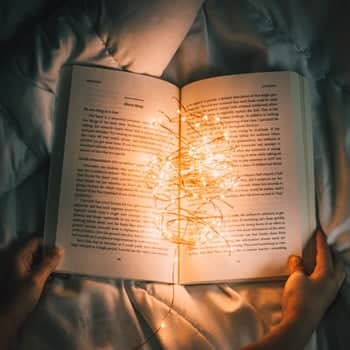Podcast: Download
Subscribe: Apple Podcasts | RSS
 The reason why nearly every visualization reading strategy fails is simply this:
The reason why nearly every visualization reading strategy fails is simply this:
Visualization is not about seeing pictures in your mind.
It’s about multisensory visualization based on a strategic process with a well-defined outcome — better comprehension and memory.
If you’re tired of Googling “reading strategies visualization” and finding the same ineffective talk about creating “pictures in your head,” get ready for the real deal.
Here’s what this post will cover:
What Is Visualization In Reading?
3 POWERFUL Benefits of Visualizing While Reading With KAVE COGS
5 Easy to Implement Visualization Reading Strategies
The Ultimate Visualization in Reading Tactic
What Is Visualization In Reading?
Visualizing text while reading is just what it sounds like: mentally picturing images and ideas as you read. Simple, right?
Not so fast!
For example, how do you “see” the concept of visuality itself? Chances are, so many possible answers emerge that the visualization of visualization quickly falls apart.
Then there are those with aphantasia — these are people who are said to not have a “mind’s eye.” Yet other people actually see text versions of the words they hear. It’s called ticker tape synesthesia (and is very rare).
The fact of the matter is that there are many kinds of mental imagination, and to reduce visualization down to “pictures” is simply false.
Instead, it can be any of these imaginative processes:
- Kinesthetic: imagine the feel and weight of binoculars and how they feel when you put them to your eyes.
- Auditory: hear the sound of an electronic microscope zooming in on a subject.
- Visual: specifically imagine the color of a camera’s metal and plastic parts, or how the light bounces off its surfaces.
- Emotional: imagine how it feels to see a loved one again after a long time apart.
- Conceptual: think about the concept of something being visual, perhaps by imagining the word itself appearing on a screen.
- Olfactory: imagine the smell of rain after you’ve heard distant thunder and seen a lightning clap.
- Gustatory: imagine the taste of that same rain.
- Spatial: think about the size of your vision in terms of how far you can see or how big objects are relative to one another.
To remember all of these options, think of the words “KAVE COGS.” Then, whenever you read, move through each step strategically in order to make sure you’re using multisensory visualization.
The next step is relational, which makes any word instantly multi-sensory by creating associations.
Let’s take a well-known example:
“Life changes fast. Life changes in the instant. You sit down to dinner and life as you know it ends. The question of self-pity.”
— The Year Of Magical Thinking, Joan Didion
The first thing to do here is focus on the first word and think about images that relate to it.
For example: life cereal – life magazine – the tree of life.
Think of as many as you can in the beginning and run them each through KAVE COGS.
Then think about change. You might bring to mind a handful of coins or magicians you’ve seen who quickly change their uniforms. Again, run your choices through KAVE COGS.
“Fast” offers many options — and to give you an example of the conceptual mode from KAVE COGS, you can think about the practice of fasting.
Keep going until you’ve completed each word of the Didion example (or an example of your choice).
With practice, you’ll be able to select keywords from sentences, find associations for each, and run them through the multi-sensory tool I’ve shared.
Next, let’s examine the positive impacts of doing this.
3 POWERFUL Benefits of Visualizing While Reading With KAVE COGS
With a visualizing comprehension strategy like KAVE COGS in place, you’ll soon experience the following benefits:
1. Greater Focus
Having the ability to seize upon every word simply by creating an association and running it through KAVE COGS means you always have a way to keep concentrated on a text you’re reading.
If you find you want even more granular “hooks” while reading, you can create associations at the level of the letter using the pegword method.
As learning expert Dr. Erica Warren demonstrates, this kind of visualization has been cited as useful for focus as far back as Aristotle circa 384 BCE.
2. Greater Memory
When you tap into all of your sensations as part of how you visualize text, you’ll remember more.
For example, “Life changes fast” leaps instantly to mind because I can taste the cereal, feel what it’s like to change clothes quickly, and have the taste of that first morsel of food following a period of fasting.
The tactics on this page are just one reason scholars Bob Algozzine and Patricia Douville urged teachers to use mental imagery across the curriculum. But you don’t have to be a student — anyone can benefit.
3. Greater Comprehension
When you have a reading comprehension strategy like multisensory visualization in place, you’re going to understand more.
This will happen because when your focus goes unbroken and you can remember through association, your brain percolates information better. The better your memory and concentration, the more you can compare and contrast ideas.
Pro tip: Make sure to set aside time just for reflection. A lot of people simply consume information through reading, but without active recall efforts, you’re less likely to understand the material. I suggest writing summaries of everything you read to promote better understanding.
Why does this work?
Largely because we’re tapping into what the memory scientists Lockheart and Craik called “the levels of processing effect.” They basically showed that approaching information from multiple angles led to deep processing instead of the typical shallow processing that holds so many learners back.
Now that you know why it’s beneficial, let’s look at a few ways you can implement a visualizing comprehension strategy.
5 Easy to Implement Visualization Reading Strategies
Now that you know the basics, here are some suggestions for how to put it into practice:
1. Use a Bookmark
Write KAVE COGS down on an index card and use it as a bookmark. It will help remind you to use the strategy while reading.
Or if you read from ebooks, put the card on your wall or anywhere you’re likely to see it.
You can also use a Memory Palace to memorize the formula. Here’s how you can learn more:
And once you’re comfortable using Memory Palaces, you can move on to the next step.
2. Start Small
Now, you might be thinking… “Start small?… How is that a strategy?”
Given that so many people overwhelm themselves by taking on everything all at once, being selective and breaking things down really is strategic.
To do this, start with just one sentence. To ease your way in, count the words and then get an image of the number in your mind. Then think of something else that has that number.
For example: if you count four words, you could think of The Beatles, a music group of four members.
Then continue with the first multi-sensory mode: Kinesthetic. Really explore it before moving on to the next.
3. Exercise Your Brain
Complete regular visualization exercises and sensory memory exercises.
4. Mind Map
Mind mapping is a fun and easy way to keep notes visually. As you capture each idea on the page, run it through the KAVE COGS formula. You might want to assign a color to each so you’re able to spot the precise visualization at a glance.
For example:
Kinesthetic = Kiwi green
Auditory = Apple red
Visual = Violet
Emotion = Eggplant purple, etc.
The use of colors might seem like an additional step that isn’t worth the time. However, as reported in Prospects for Scientific Visualization as an Educational Technology by Douglas N. Gordin and Roy D. Pea, adding colors helped learners perceive and understand information far better than black and white readouts.
For more help with mind mapping, please check out this detailed video playlist:
But it’s not just video that’s helpful.
5. Create Written Summaries
Spending 5-15 minutes writing out everything you remember from your reading by drawing upon your multi-sensory visualizations is one of the best strategies.
To start, sit with a blank sheet of paper and your pen or pencil. Write down the title of the reading. Then let the first thing that comes to mind arise — do this without writing first. Then write out the details.
You don’t have to lay out the information in any particular order of importance. The exercise is just to call back to mind what you remember and lay it out in your own words.
You can also revise or rewrite your summaries.
For example, I wrote many summaries on large index cards when researching my Ph.D. dissertation. Later, I rewrote many of them into my dissertation itself. Because my reading strategies visualization tactics were solid, I automatically remembered more and understood everything with greater depth.
And the best part is that you’ll find you understand things with greater humility too.
When you find that you can’t remember details, you can go back and fill them in. Or, you will benefit from bumping into the limits of what you don’t know and carry on with other books you need to read.
The Ultimate Visualization in Reading Tactic
At the end of the day, if you put just 10% of KAVE COGS to practice in your reading over the next 90 days, your visualizations skills are going to dramatically increase. I personally read a ton of information that most people would consider “dry and boring.”
But the truth is that when you can dig into each letter of every word and find a ticket to your very own “Mental Disneyland,” there will never again be such a thing as dry or boring in your reading life.
And remember, the Memory Palace is the by far the best of all possible strategies, especially when combined with visualization meditation. When you get really good at it, you can use each page as a Memory Palace.
To do that, you want to not only create associations for each word, but also each number. This is a fairly advanced tactic, so I suggest everyone start with the ideas I’ve shared here first.
So when you’re ready for more, dive into the Magnetic Memory Method world — starting with the free memory training.
Related Posts
- Reading Comprehension Strategies: 13 Ways To Eliminate "Rewinding"
Good reading comprehension strategies are hard to find. This resource gives you comprehension techniques for…
- Memory Athlete Braden Adams On The Benefits Of Memory Competition
Braden Adams is one of the most impressive memory athletes of recent times. Learn to…
- 7 Active Reading Strategies That Help You Remember More
Active reading strategies are often poorly misunderstood or lacking. Get these 7 active reading activities…











